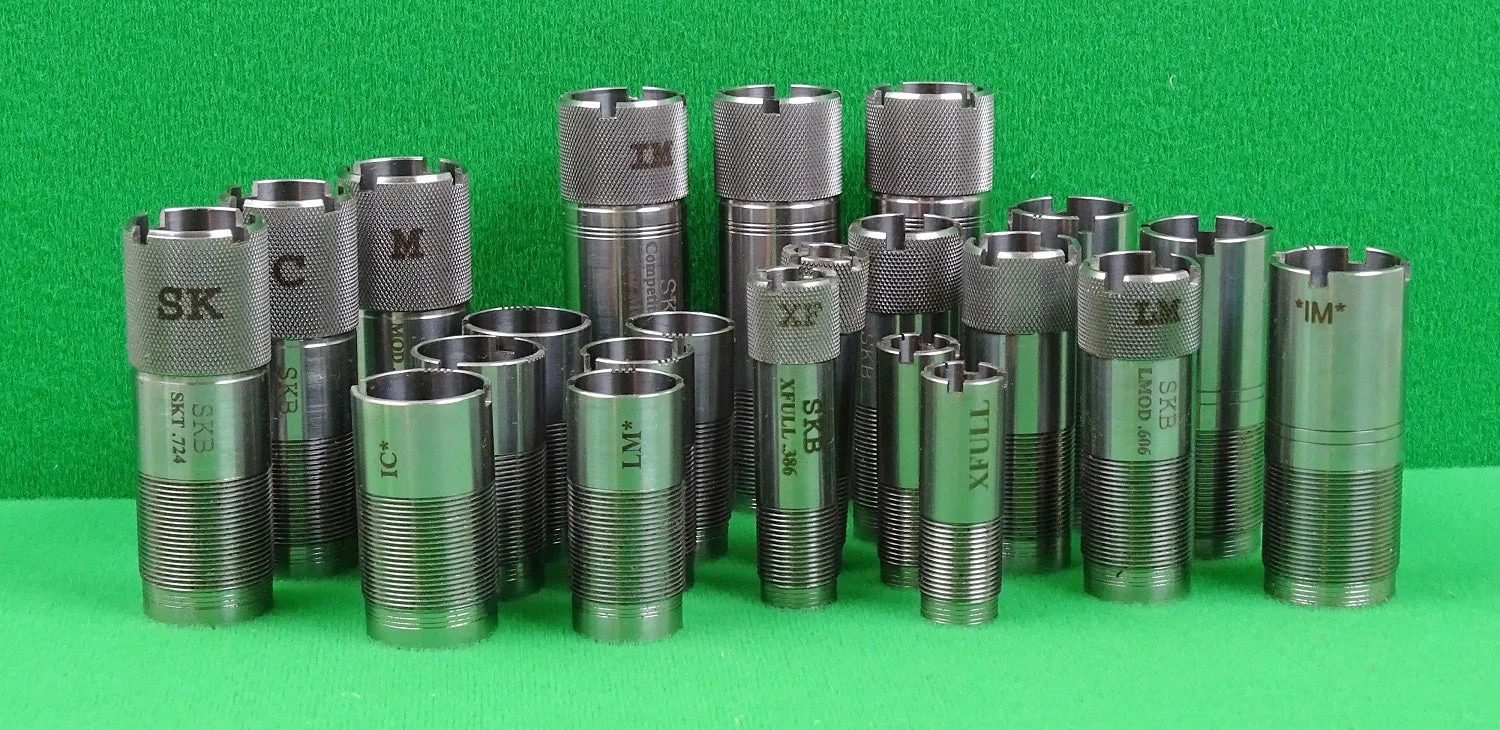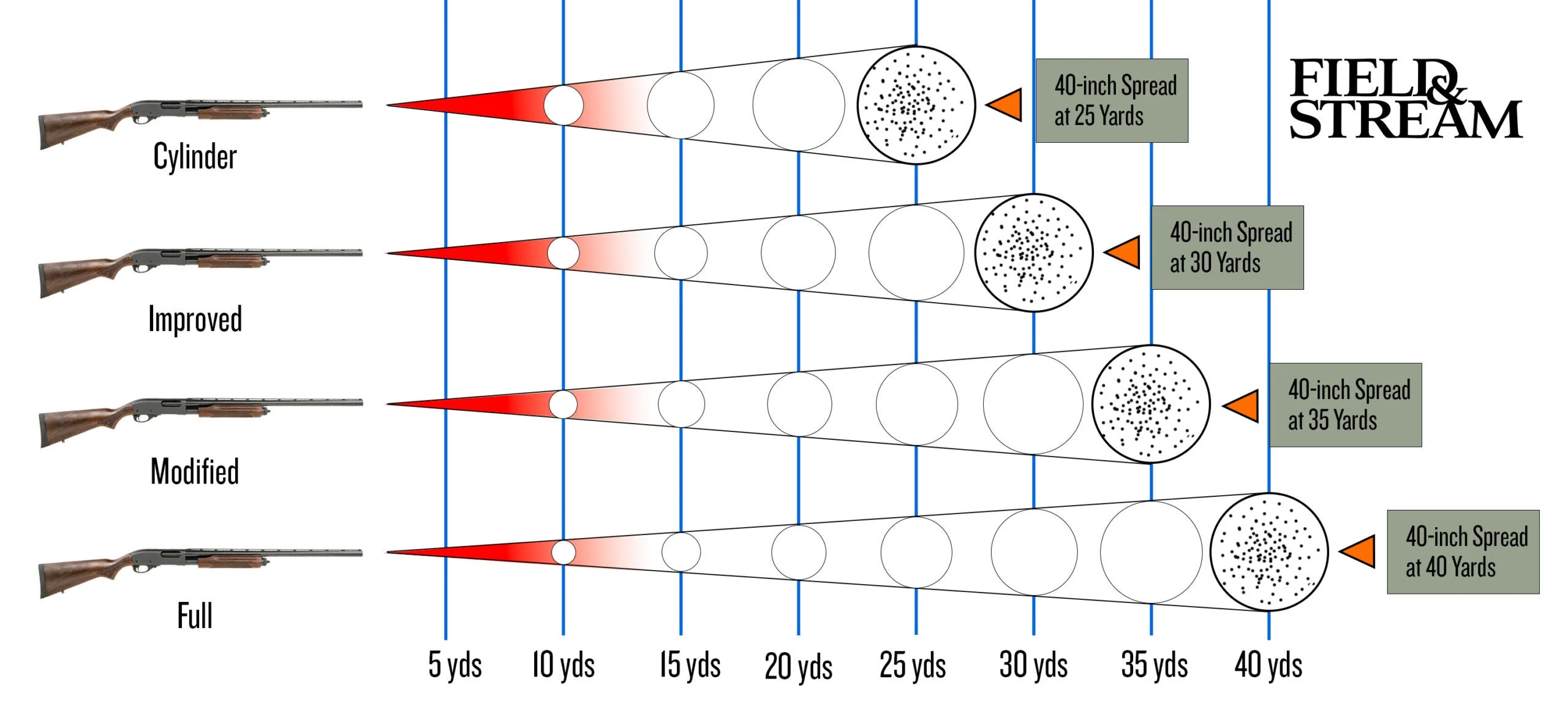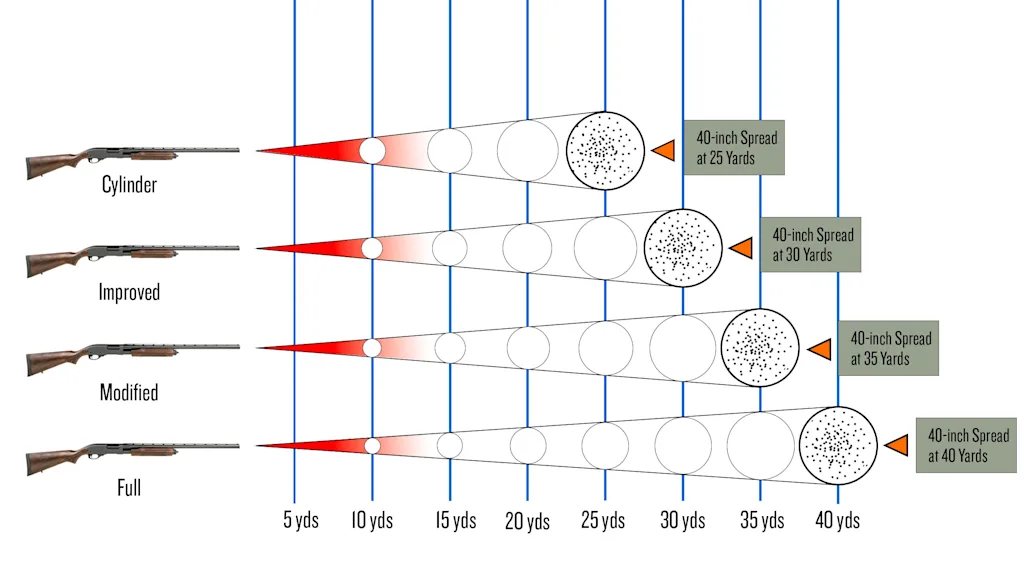We may earn revenue from the products available on this page and participate in affiliate programs. Learn more ›
A shotgun’s payload of pellets flies downrange in an expanding, lengthening swarm. The choke in the gun’s muzzle determines the height and width of that swarm. “Choke” is the taper in the last inches of a shotgun barrel. No one can agree on who invented choke boring, nor when, but by the latter part of the 19th century, most shotguns were choked. Almost all of those chokes were fixed, meaning the tapers were bored into the barrel and couldn’t be changed. Most guns made in the last 35-40 years feature threaded chokes that can be switched in seconds, allowing you to tailor your gun’s pattern to suit different types of shooting by changing chokes.
Shotgun Chokes Explained: How a Choke Works

As for how a choke works, the easiest analogy is to think of an adjustable hose nozzle. Tighten it down, constricting the end, and you get a narrow stream of water that can spray far away. Turn it the other way, and you get a spray that covers a wide area at close range. A shotgun’s choke does approximately the same thing with a shot charge by squeezing the payload as it reaches the end of the muzzle. Because the shot cloud continues to expand and lengthen as the pellets fly farther from the muzzle—think of it as a cone—a choke lets you optimize the size of that cloud to be most effective at the range you will be shooting.
Shotgun Chokes Explained: Pattern Testing
The ideal shot pattern is broad enough to hit with more easily while being dense enough for a clean kill or solid break on a clay target at a given distance. If a pattern is too tight, it’s harder to hit the target and you risk overkill and torn-up birds when you do connect. If a pattern is too open, you may not put enough pellets on target.
To choose the best choke, think about the range you’ll be shooting your targets. Be ready to pattern your shotgun, too. The only way to know what your shot looks like downrange is to shoot at paper. Traditionally, patterns are shot at 40 yards, and while that’s fine, you should test your gun’s chokes at the ranges you shoot your birds or targets. Be aware, too, that choke is only half the equation. Different-sized pellets, different velocities, wad types, and the presence or absence of buffer material all affect how a given shell performs with a choke. To get a snapshot of what’s happening downrange, pattern-test by shooting at a sheet of paper at least 3’x3’. If you can, shoot at least three patterns (five is better) with each combination—as no two patterns are exactly alike. Draw a 30-inch circle around the pattern, using the densest part as the center. Try shooting patterns five or ten yards closer and further, too, to give yourself an idea of how the pattern is spreading.

Shotgun Chokes Explained: Types of Chokes
With a few exceptions, guns made before the 1980s had fixed chokes that were bored when the barrel was made. Although fixed chokes limit you to one choke per barrel, they can be versatile if you take the time to test different shells in them. And, there is no maintenance required of a fixed choke beyond regular barrel cleaning.
Before screw-in chokes became widely available, there were some adjustable choke devices like the Cutts Compensator and the PolyChoke. PolyChokes worked very much like an adjustable hose nozzle in that they consisted of a collet and a sleeve you could use to open or tighten the choke by turning it.

Screw-in chokes come with almost all guns now, and there’s a wide selection of aftermarket chokes as well. Generally, chokes are either flush, so you can’t see them, or extended. Flush chokes retain a gun’s traditional looks and often perform quite well, especially the longer models. Extended chokes that stick out an inch or so from the end of the barrel are very popular among waterfowlers, turkey hunters, and target shooters. The extended choke moves some of the stress and pounding caused by large, hard pellets outside the barrel, minimizing the chance of gun damage (it takes a lot of shooting to damage a choke, but it can be done). In some cases the longer interior of the extended choke tube allows clever choke makers to improve patterns, often by adding a long, parallel section inside that helps stabilize the shot load. Extended chokes are also very easy to change, which makes them appeal to some target shooters who like to change chokes during a round of sporting clays to match the near and far target presentations.
Some extended tubes also feature ports or studs inside, which improve patterns by slowing the wad so that it releases the pellets cleanly and without disruption.
List of Shotgun Choke Constrictions by Diameter
Cylinder bore (.000”)
Improved Cylinder (.010”)
Light Modified (.015”)
Modified (.020”)
Improved Modified (.025”)
Full choke (.030”)
XX-Full (.040”-.090”)
Rifled Chokes

Chokes are both named and referred to by the amount of constriction in thousandths of an inch. Here are the most common chokes and their best uses:
Cylinder bore (.000”)
True Cylinder is no choke at all. It is best for very close-range shooting, such as rabbits or woodcock in heavy cover. It shoots a wide pattern at ranges of 15-25 yards, but those patterns quickly become sparse after that. It’s also a good choke for shooting full-bore deer slugs from your shotgun.
Skeet (.005”)
Skeet choke, also known as “Skeet 1” is for the kind of close-in targets you see on the Skeet field, which range from a few yards off the muzzle to 20-25 yards. It’s a good choke for heavy-cover upland hunts for ruffed grouse or quail in the woods. And, as the name suggests, it’s an ideal choke for the game of skeet.
Improved Cylinder (.010”)
Also known as “¼ choke” in England, IC is a standard choke for all-around upland hunting. It’s also the best choice for most people for dove hunting, as its patterns at normal dove hunting distances of 20-30 yards are quite forgiving. Some duck hunters use it for close shots in the timber or during early teal season.
Light Modified (.015”)
LM, once upon a time know as “Skeet 2” is slightly tighter than Improved Cylinder. Little used for many years, it has become very popular among sporting clays shooters, as it can break targets from close range out to 40 yards with the right loads. Waterfowlers like LM, too, since it shoots good patterns for decoying birds and can still reach out a little farther to make backup shots or anchor flaring birds.
Modified (.020”)
Modified or “½ choke” makes a good all-around choke that meets many applications. It’s a good choice for big-party pheasant hunts, where shots can be longer than the ones you get over a dog. With steel and tungsten-based pellets, Modified gives you a tight but manageable spread at over-decoy ranges and has some reach for longer shots. It’s also a good choke for 16-yard trapshooting, where the average shot is 30-plus yards from the gun. Modified choke also patterns well with large buckshot.
Improved Modified (.025”)
Splitting the difference between Modified and Full choke, IM is another good choke for trapshooting, and a good choke for longer passing shots at waterfowl with larger steel and tungsten-iron shot that may damage a tighter choke. If you pair an Improved Modified in one barrel of an O/U with Light Modified or IC in the other, you have a versatile gun suited to long and short targets on the sporting clays course.
Read Next: Types of Shotguns: A Complete Guide
Full choke (.030”)
Once very popular among waterfowl hunters, especially in the long-gone lead-shot/fixed choke days, Full choke has fewer applications in the non-toxic era. In some cases, Full chokes are even stamped “not for use with steel shot” as the pounding of hard steel pellets through the tight constriction can damage the choke and barrel. Full remains the best choice for long-range shooting with lead shot, and it is very popular among trapshooters, as it has the reach to break targets from as far back the 27-yard line.
XX-Full (.040”-.090”)
“XX-Full” is a catch-all term for a variety of very tight constrictions primarily used by turkey hunters. Since turkey hunters hope to make headshots with a tight cluster of pellets, they don’t care what the outer fringe of the pattern looks like, and XX-Full chokes deliver very dense “hot centers” to saturate the target with as many pellets as possible.
Rifled Chokes
Typically of cylinder bore, rifled choke tubes are designed to better stabilize shotgun slugs in otherwise smoothbored barrels. There are also gently rifled chokes that actually disperse a pattern and make it open up very quickly for ten- and fifteen-yard shots.
FAQs
Q: What do different chokes do on a shotgun?
The choke in the shotgun’s muzzle determines the height and width of the swarm of pellets that flies downrange and expands.
Q: What are all the choke tubes in order?
The following list refers to choke tubes by diameter: cylinder bore (.000”), skeet (.005”), improved cylinder (.010”), light modified (.015”), modified (.020”), improved modified (.025”), full choke (.030”), XX-full (.040”-.090”).
Q: What does 3 dots on a shotgun choke mean?
Every choke is marked with a particular number of notches on the front end. This makes it easier to identify what choke is in the gun without removing it from the barrel. Three notches symbolize a modified choke.


